Note: Click the images below for larger versions, or see them all here.
In May of 1980, my father worked for AT&T. This was in the early days of transmitting news photos across the country electronically. It may have been part of the wire service; I'm not sure.
In the middle of the month, he began bringing home pictures of some mountain in Southern Washington, that was about to rock the world. Those 8 x 10s showed the early stages of the infamous Mt. St. Helen's eruption.
A few days after the volcano erupted on 1980-05-18, we put a piece of white styrofoam, half covered in plastic wrap, on the back patio. Gradually ash from the volcano accumulated on that little tray in New York City.
(I guess it's possible that was regular NYC soot and not actual volcanic ash, but the ash cloud did circle the world so I'm sticking with the idea it was ash.)
I've posted aerial pictures of the volcano in the past (here and here), but on Friday we actually got to see it from the ground. It really is an amazing spectacle.
The weather was perfect today. The sun was out and it was about 70 degrees. Interestingly the best weather to see Mt. St. Helen's is pretty much the opposite of the best weather to see Northwest Trek.
The drive up gave some hint about the kind of views we would get.
This view is from the edge of the 1980 blast zone. All the green vegetation in this picture grew on the blank slate the 1980 eruption created.
A few miles up the road at the Weyerhaeuser forestry learning center/rest area we had a nice, clear image of the volcano in the distance.
When the mountain exploded that morning, it blew off its north side and 1,300 feet of the mountain top itself. Most views focus on the gaping crater. What I like about this one is that I can see the jagged edges at the top. It looks like a broken mountain that had the top ripped off. I can visualize the summit that used to be there, but is now spread out across the valley floor.
We continued up the road to the Johnston Ridge Observatory. The facility is named for David Johnston, a vulcanologist who perished in the eruption. It's one of the most popular Mt. St. Helen's tourist facilities.
From there I had views like this:
Mt. St. Helen's isn't done yet. It's still erupting. After being fairly quiet from 1986 to 2004, the mountain started growing again. According to rangers at Johnston ridge, it shot up 7 new spines (rock formations), some growing as much at 30 feet a day.
You can see the dramatic landscape inside the crater here:
That's not fog in there; it's steam escaping from molten magma below the surface.
The 1980 blast blew out the mountain, killed 57 people, created the largest landslide in recorded history and flattened trees for miles around.
Thousands of monstrously old trees were simply blown over like blades of grass. You can see them here, all pointing away from the mountain.
Obviously, if that blast happened today, the Johnston Ridge Observatory would likely be destroyed. The parking lot is right in the heart of the blast zone.
Trees that survived being knocked down were killed where they stood. The rocks, debris and superheated gasses blasting through the air seared the wood and stripped them of all their vegetation. These ghost forests still stand today.
But these dead trunks are remarkably beautiful
One of the most striking thing about the landscape is not how desolate it is, but how life has found a way to come back.
As Dr. Malcom said in Jurassic Park, "...life, uh, finds a way."
2008-08-23
Subscribe to:
Post Comments (Atom)


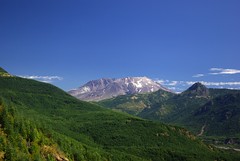
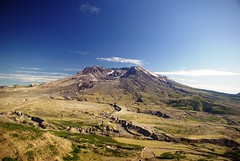
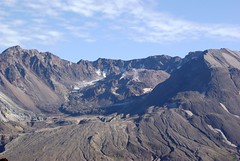
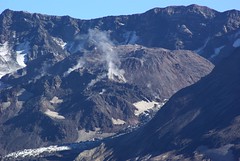
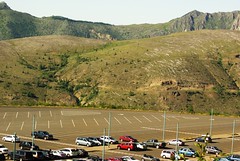
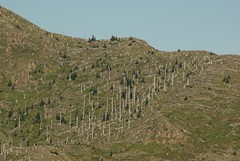
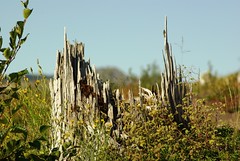
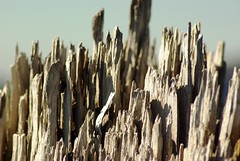

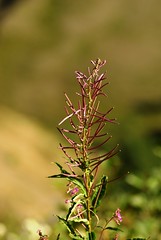
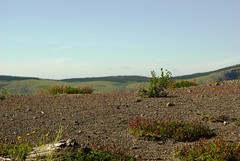
8 comments:
Wonderful shots and a good recovery for the area
Beautiful photos! Thank you for sharing!
I remember hearing about the eruption, when I was young. I always wondered what would happen to the earth around it.
Now I know.
It just simply became beautiful again.
Absolutely stunning pictures. I am curios, were you able to get any of the famous Helenite gemstones? They are such a beautiful stone.
really a beautiful shots..I love these photos :)
Awesome post! Breathtaking just breathtaking......
Thank you for sharing.
Ironically, my husband and I were just talking about the Mt. St. Helen's eruption the other day. He was a small child living in northern Idaho at the time of the eruption, and remembers his mom putting a face mask on him and sending him outside to play in the soot. What a memory to have!
BTW, I'm a visitor from EntreCard and I'm really enjoying your blog!
Love the pictures. One of these days while up in Seattle seeing my family again, I think I'm going to drive down there.
@Cathy M, zyriana.com, malineya, the fearless blog,tiffany aller: Thanks. The views were amazing. I'm trying to learn how to do justice to them with the camera.
@melissa: Thanks. I didn't pick up any of them, but maybe next time. I also didn't do the Hummocks Trail which is supposed to be amazing.
@tazdog: If you can do it, it's worth the trip. It's better if you can share the driving with someone. It's not too far, but that Seattle to Castle Rock drive is surprisingly tiring.
Post a Comment